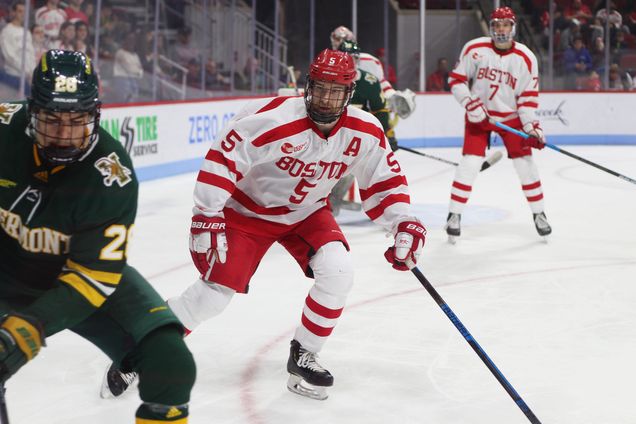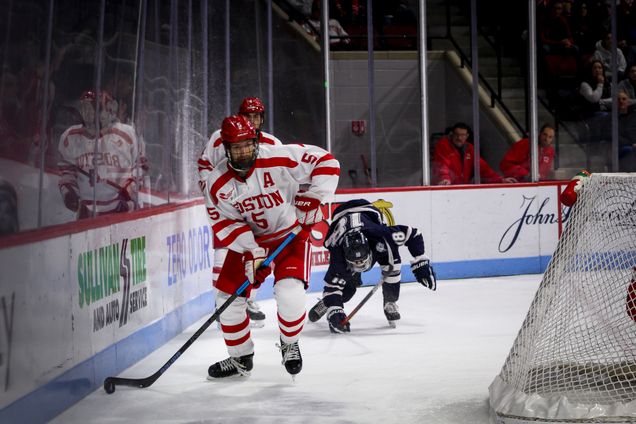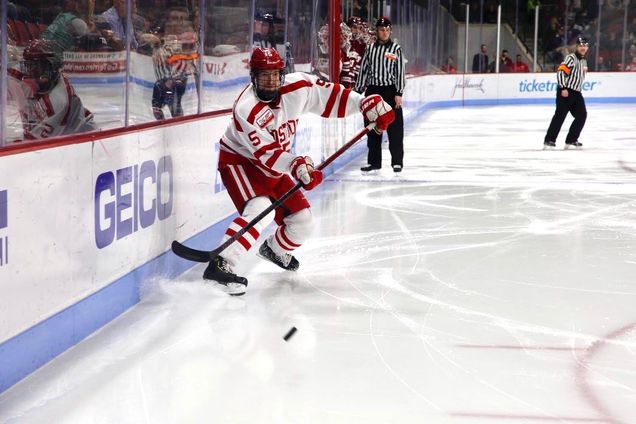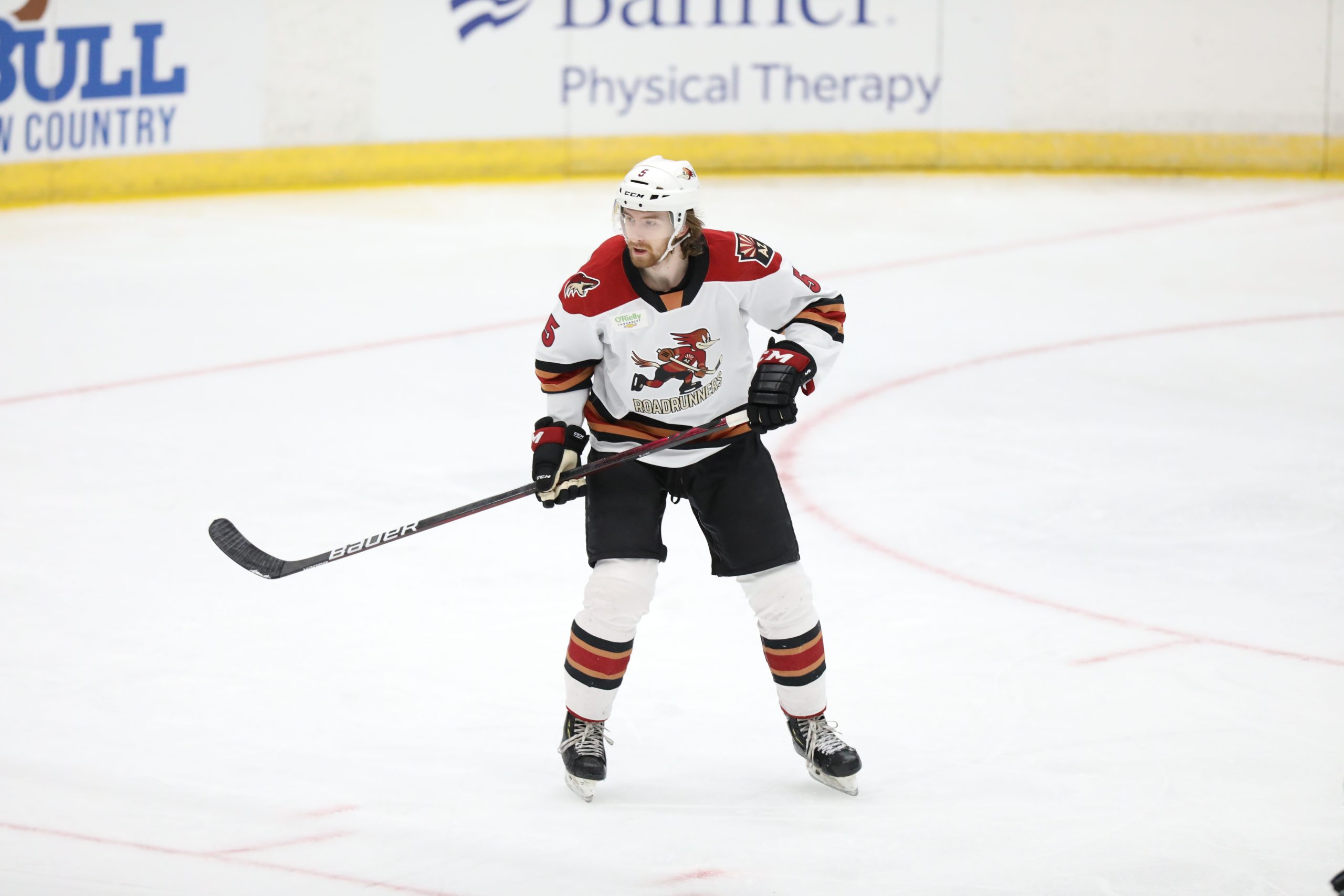From Norway to Tucson: Cam Crotty adjusting to pro hockey in a COVID world
By Patrick Donnelly
Cam Crotty’s transition from college life to professional hockey has been anything but typical. Due to the COVID-19 pandemic, the former Boston University defenseman dealt with an abnormal offseason in 2020, a delayed professional season, lengthy quarantines and hotel stays, going overseas to play in Norway, and more.
After BU’s season was abruptly cut short before the Hockey East playoffs last season, Crotty turned pro and signed his entry-level contract with the Arizona Coyotes, the National Hockey League club that selected him 82nd overall in the third round of the 2017 entry draft.
During his time on Comm. Ave., Crotty played in 102 games over three seasons, recording 10 goals and 17 assists for 27 points. Serving as an assistant captain as a junior last year, he posted 4-5-9 totals in 30 contests.
"How We Took The Lead"
– by Cam CrottyCo-authored by Curry & Wise#GoBU pic.twitter.com/hP5p4QWY6a
— BU Men's Hockey (@TerrierHockey) February 22, 2020
The Greely, Ont. native played his last game for the Terriers on March 7, 2020, a 2-1 loss to Northeastern on home ice at Agganis Arena to close the regular season. Little did anyone know, Crotty, and many of his peers, would have to wait months to suit up again. On Nov. 12, Crotty skated in a game for the first time in 129 days with Sparta Sarpsborg of the Eliteserien, Norway’s premier hockey league.
Fast forward another two months, and Crotty is fresh off Coyotes training camp, seeing his first professional action in North America and skating with the Tucson Roadrunners, Arizona’s American Hockey League affiliate.
This season, Crotty has skated in eight AHL contests for the Roadrunners, where he has notched an assist and a plus-two rating. While in Norway, the 21-year-old appeared in seven games, posting three helpers, eight penalty minutes and a minus-three rating.
Former Boston University defenseman @Cam51Crotty earned his first professional point last night with the Tucson Roadrunners (AHL).
Crotty takes the pass from his defense partner and sends an indirect shot off the end boards. Kevin Roy is right there to stuff the rebound home. pic.twitter.com/XAtCECIXEY
— Patrick Donnelly (@PatDonn12) February 16, 2021
On Tuesday, Crotty took time to reflect on the last year, his decision to sign his NHL contract and the adjustment from college to pro hockey.
Patrick Donnelly: Going back to the fall, how did the opportunity to play in Norway come about?
Cam Crotty: “It’s super weird, thinking back to it. I was in Ottawa, and it was about early October when we started tinkering with the idea because at that point the guys at BU went back to school and the guys in the same situation as me were just training for six months.
“Anyways, between my agent and Arizona, they kind of said there’s a possibility of going overseas and playing, and there were a bunch of guys who went over and played in Sweden and Finland, like Kasper [Kotkansalo], who’s playing in Finland for the year.
“So, my agent and Arizona said there’s a team in Norway that needs right-shot D-man. I thought ‘perfect. Why not?’ I think it was October 27 or 28th, and I got on a flight to go out there. It was pretty crazy and it came together within, maybe a week or two of figuring out if I should go and play somewhere. I was there for a month and a half or so, and I got back on Christmas Eve for Coyotes camp and was there for a month.”
PD: What was it like overseas with the different ice surface and different style of play?
CC: “I mean the ice is huge. I know at BU we have a sort of hybrid, so it’s pretty big, but it’s not super huge. It’s still a big ice surface – I guess they’re playing at Walter Brown Arena this year, so it’s not like Agganis. But it was huge in Europe, there’s so much room. I was joking with my buddies, who asked about it too. I only played seven games there, but I think I might have gotten hit maybe once a game, not very much, which is crazy — especially for a defenseman and getting forechecked all the time.
“There’s tons of room to make plays and keep the puck. You have a little bit more time. There’s more of an emphasis on keeping the puck, but sometimes in college and the North American game, it’s a lot more of playing fast, dump the puck in, forecheck, get it back and all that, whereas over there, there’s a lot more cutting back, keeping the puck and trying to find your plays.
“It was cool. It was a different style of hockey and I had a lot of fun.”
PD: Culturally, how was it different?
CC: “It’s really hard to explain in words, but just being there felt different. It wasn’t too crazy. Most people spoke English, so I wasn’t completely lost when I went to the grocery store or anything. It was nice. They set me up with an apartment, a car and all that.”
PD: Following up on the different style of play and getting more touches with the puck, do you think it helped you along in that area, especially where there’s more of an emphasis on it in the pros these days?
CC: “Yeah, for sure. The pillars of my game will always be on the defensive side of the puck. I think it just helps with keeping the puck more. It forces you to be more comfortable in certain situations, like getting the puck on the blue line, taking a quick look and having an extra second to try and find a play, or when you’re skating up ice. It 100 percent definitely helps with that.”

“Coming back, it’s a little bit different, obviously. Yes, you have less time. So that was a bit of a transition again. I think it can only help. There were some parts of that game that kind of played well, that’s one of the areas, and then others that weren’t as realistic just because of the ice surface. But I think all in all, it helps and that’s one of the areas of my game that needs to continue to get better in order to keep growing as a player.”
PD: Going from Norway to Arizona, how has the transition been in Tucson now?
CC: “It was tough. I think everyone’s tired of hearing about quarantines and stuff, but in today’s game it’s a big part of it. I came back from Norway on Christmas Eve, and I had to quarantine for, I think it was, 11 straight days total, where I was basically bound to a hotel room. Once I got out of that, camp started. It was tough, being my first NHL camp and then also coming off of basically two weeks in quarantine, sitting in my bed and stuff.
“But it was good. It obviously would have been a hard transition anyways from from college, and I only played seven games in Norway. There’s obviously a level difference there too, so it was a big step up. I went in with my eyes wide open, my ears open, and learned as much as I could.
“Maybe it’s a simple way to put it, but everybody’s good. Everybody is just really good. I think, in college, juniors and other levels, there’s still a difference between your top forward to your bottom forward, and your top D-man to your bottom D-man. That margin gets really, really thin at this level. I think that’s the biggest change. Everybody can play. It’s not like you’re hopping out there, the first pair against their third pair and you’re like ‘wow I can just do whatever I want out here.’ That difference just isn’t there.”
PD: To that point, I think it’s funny when fans say “oh, X fourth liner stinks,” when you have to take into account how good any player is to be a professional in the first place.
CC: “Yeah. You take into account most fourth liners were the guys in juniors, where they put up 100 points. You’ve got to be really, really good to be a fourth liner or a third pair defenseman in the NHL.”
PD: So while you’re in quarantine, were you doing anything to stay in shape at all in your hotel room or did you just kind of have to hang out?
CC: “I mean you try your best, but you’re not allowed to use the hotel gym or anything. So you can go out and run in the parking lot or do pushups in your hotel room, but it’s tough. Even at the start [of the pandemic] back in April and May, unless you had a home gym, you were kind of battling and trying to figure stuff out. It’s tough — you can only do so much.”
PD: More on the point of last offseason, what is it like physically and mentally preparing to make the jump to the pros with all the uncertainty?
CC: “It was a unique situation, obviously. I think I would have loved to be able to, in another universe, see what that would have been like in a normal year. For guys who sign and go into their first year of pro, there are so many things that you do in preparation. There’s the rookie tournament, and you get to maybe be at training camp for a little bit. This year that was all changed.

“But, it was a lot of excitement. I know in the first couple months after I made my decision to sign, I was, in some ways, mourning my decision of leaving BU. Obviously I loved being at school and it was sad to be leaving like that. At the same time, I was really excited to be turning pro.
“It was more just excitement for those number of months and then once you got to August and September it was like ‘okay, when is the season going to start? When are we going to get to do stuff?’ And as I said, I was at home in Ottawa until basically the end of October. I haven’t been in Ottawa past August since I was 15 or 16 years old, so that was pretty crazy.
“From the preparation standpoint, I think I was really excited the whole time, obviously there were nerves and angst because there’s that big level difference.”
PD: You mentioned the decision to sign your contract. What went into that process and pushed you to turn pro?
CC: “It was a long process for me because our season got cancelled March 12. I ended up making my choice in the second week of April, so I took four weeks to make my decision. I’d be lying to you if I knew from the start once I had the opportunity to sign that I’d be leaving.
“It was a lot of days talking to buddies, talking to guys like Shane Bowers, who left BU in 2019, and leaning on guys trying to figure out what was the best move. COVID was a factor, obviously at that point we had no idea what the college season was going to look like the next year.”
“At the end of the day, it came down to a gut feeling. Thinking back to when you’re three or four years old when you put on your skates for the first time and watch your first hockey game. You think, ‘wow, I want to be there.’ And I thought, ‘you know what? I’m going to chase this thing for real.’
“It’s one thing when, if you get drafted, you think you’re close. But to be able to sign the contract and really become part of the organization, it just feels like a really tangible step towards it. So, at the end of the day I think I was just thinking back to being a kid, what the dream was and what it still is.”
“But it was really sad leaving BU. When I came in, I wanted to be a four-year guy, and wanted to be a captain at the program. It was a tough sacrifice, but I think I just had to make the sacrifice for my dream.”
PD: One last thing on the offseason, obviously no one knew BU wouldn’t start until after the new year. But, when Hockey East announced its plans in the fall, and the pro season was still in limbo, was there any part of you that wished you had stayed?
CC: “Of course. We didn’t play our first game until February. By then, BU had already played a handful of games and some college teams already played 15 games or so. I’m sitting there in my head, saying, ‘Damn, did I really mess this up?’ Those are the days that are tough, but then you realize, it’s still the right decision.
“I think the hard part I keep going back to is that I was just at home with my family, but I was by myself in a way. All my friends were at school. I was seeing Snapchat or Instagram posts about all my buddies and teammates at school. They weren’t playing yet, but they were there. That was the hardest part, where I really missed that experience, but it’s all worked out so far.”
“I give props to Bowers. I was talking to him a lot in the summer before I made my choice and he said to not think there’s one right choice or wrong choice, either would have been great.”
PD: You missed them by a year at BU, but you’re teammates with Terrier alumni Doyle Somerby and Connor Lacouvee, and Clayton Keller is with the big club. Has having a network of BU guys helped your transition?
CC: “For sure. I don’t know Keller that well, but I’ve talked to him a few times. I met Lacouvee before. I hadn’t met Somerby, but I knew who he was with his BU ties. It was almost an easy segue. If he’s at the rank I’m instantly a little more comfortable just because I’ve got someone I know. I don’t know Doyle from BU, but I know Doyle from here, and we have that BU connection. It’s crazy having three guys from BU in the organization. It’s a small world.”

PD: In your eyes, what has been most challenging about the adjustment from college to pro hockey, whether on or off the ice?
CC: “Honestly, I think the biggest difference is off the ice with your time. I wake up and go for workouts, meetings and practice, and then I’ve got nothing for the rest of the day. In college, you’d have class in the morning, practice and homework and class after.
“Now, I’m in the situation where I’ve got a ton of free time. It could be a really good thing or a really bad thing. I think right now I’m trying to figure out some hobbies or things to do on the side. I’m also gonna take some classes in the summer, and maybe next year I’ll take some during the year to finish up my degree.
“I think that’s one of the differences that most people don’t realize and I didn’t even think about until I was here. The biggest thing is just how much damn time you’ve got after practices and games.”
Featured Image courtesy of the Tucson Roadrunners.
